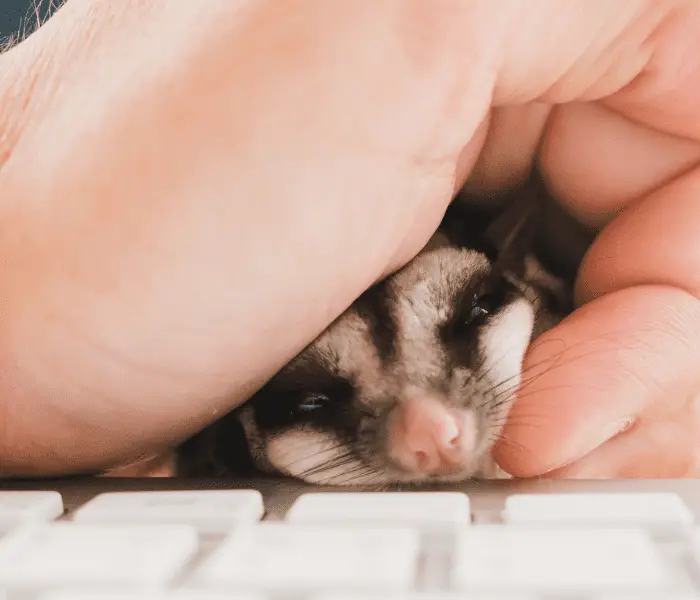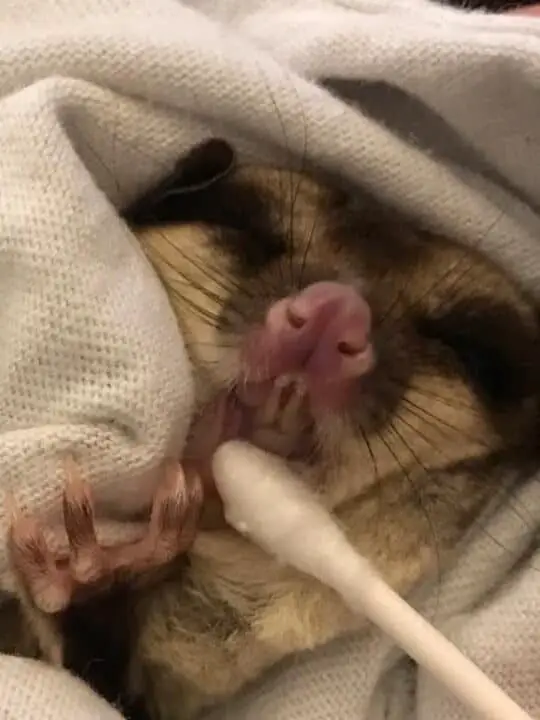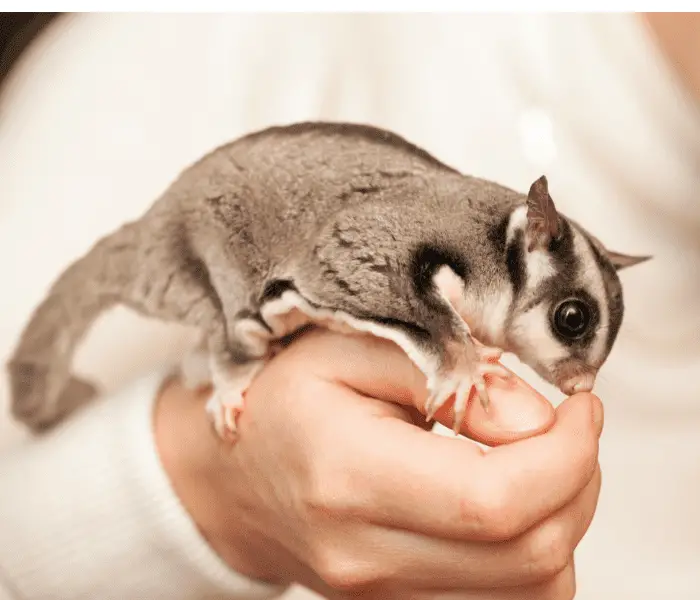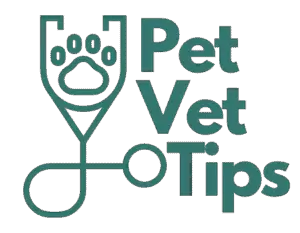
Sugar gliders are omnivorous, tree-dwelling marsupials who are most well known for their ability to gracefully glide from one place to another by using the membrane connecting their fore and hind legs. Sugar gliders can be very entertaining pets but require great care and dedication.
Like other Exotic species, sugar gliders are adept at hiding signs of illness. Closely monitoring your sugar glider’s appetite will provide valuable information about their mental and physical health. A decreased appetite in your glider should always be further investigated by an experienced Exotics veterinarian.
Common causes for inappetance in suga gliders includes nutrition-related disorders, pain, infection, and stress. A sugar glider who is not eating should be taken to your vet for a full clinical examination, as these small animals can quickly become dehydrated.
This article will discuss possible causes of inappetence in your glider and the next steps required of you to rectify the underlying problem.
Monitoring Your Glider’s Daily Intake
A sugar glider should consume 15-20% of their body weight daily. If your enclosure houses multiple gliders and you are unsure which glider is not eating, house them alone temporarily to monitor individual intake. Do so by keeping your sugar gliders within close proximity of each other by, for example placing the ‘hospital cage’ next to the main sugar glider enclosure in order to minimize the stress caused by separating a glider from its colony.
Keep in mind that as a nocturnal species, gliders are likely to eat most of their food at night, and it is normal for them not to eat a large amount of food during the day. Ensure that fresh food and water are offered in the evening, and remember to place food bowls high up in the cage and not on the floor, as gliders feel vulnerable at the bottom of their enclosure.
Diseases That Cause Inappetence In Sugar Gliders
1. Nutrition-related Disease
Sugar gliders have particular nutritional needs and frequently experience nutrition-related diseases, which may lead to inappetence and general unwellness. A poorly formulated diet may predispose them to Dental and Ocular disease.
1.1. Metabolic Bone Disease / Hind Limb Paralysis Syndrome
Sugar Gliders fed a diet of only fruit and vegetables and muscle meat will experience a deficiency of Calcium and Protein, which prevents normal bone development and results in inappetence, lethargy, weight loss, tremors, and even paralysis and fractures. Your vet will diagnose this through rays and bloodwork and will treat it will Calcium injections and diet correction.
If you want to read more on metabolic bone disease caused by calcium deficiency in sugar gliders, have a look at this helpful article containing more details on symptoms, treatment and prevention of this common disease in sugar gliders.
1.2. Dental Disease
Dental Disease is not uncommon in sugar gliders, especially in gliders that are fed only a soft, high-carbohydrate diet. In addition to inappetence, a sugar glider with dental disease may show drooling and facial swelling.
In the wild, a sugar glider would use their lower incisors to chew into tree bark; it is, therefore, necessary for a captive sugar glider to have access to branches to chew on in their enclosure and for their diet to contain some coarse components to prevent the build-up of tartar.
Your vet will likely do a comprehensive dental exam under sedation to detect tooth decay or fractures. If dental disease is detected, your vet will likely perform a dental scaling or dental extraction in the case of severe dental decay. Bi-annual check-ups with your vet will allow early detection of disease.

1.3. Cataracts and Other Eye Conditions
Juvenile cataracts have been noted in young sugar gliders when the mother is fed a diet high in sugars. Sugar gliders can get territorial and may injure each other, particularly around the face and eyes, resulting in ocular ulcers. If your sugar glider’s vision is impaired, it will be difficult for them to navigate their enclosure and cause pain and stress, which will also impact their appetite.
Pet Vet Tip: Eye conditions are extremely common in sugar gliders. To read more on all the eye conditions of sugar gliders, the causes and treatments, have a look at this article.
1.5. Dietary Contaminants
Aflatoxicosis is caused by a fungus that may be found on moldy peanuts and corn. Therefore, it is recommended to feed human-grade corn and peanuts that are subject to more stringent guidelines compared to those formulated for the pet food industry.
Aflatoxins cause serious liver damage. Symptoms include inappetance, lethargy and, in advanced cases, a yellow tinge to the gums, skin and eyes.
2. Injuries
As in other animals, any condition resulting in pain will likely cause inappetence. Traumatic injuries are common in sugar gliders and may be due to collisions with doors/windows, being stepped on, or dog/cat bites. If the injury is suspected, your vet may perform X-rays to detect any fractures as well as check for any signs of secondary infection.
3. Infections / Parasite Infestations
Stress during transport or due to a change of environment may predispose your glider to respiratory or gastrointestinal infections leading to general poor health and inappetence. Along with inappetence, you may notice an increase in respiratory rate associated with respiratory disease or diarrhea or constipation related to gastrointestinal disease. Your vet will do blood or fecal tests to detect the presence of infection/infestation and treat it with antibiotics or anthelmintics.
4. Stress-related causes of inappetence in Sugar Gliders
It is essential to try and maintain a stress-free environment for your glider, as a stressed glider is likely to go off their food. Other signs of stress may include self-mutilation, fur loss, and aggression.
4.1. Poor Environmental Management
Sugar gliders are social animals and should be housed in groups of 2 or more. Being housed alone will potentially result in a stressed, lonely glider who will not be interested in food. Cage size must likewise not be too small if you are housing multiple gliders, as overcrowding can also cause stress. The enclosure must be a minimum size of 20x20x30 inches as these are highly motile animals designed for climbing and gliding freely between tall trees.
Your glider’s enclosure must contain elevated nest boxes to give them a place to feel safe. Feeding bowls should likewise be elevated off the floor, as sugar gliders feel vulnerable when on the bottom of their enclosure.
Ensure that predators are entirely excluded from your glider’s environment; your cat may look harmless to you but may be a source of stress to your glider.
Pet Vet Tip: For more details oncauses of stress in sugar gliders and what you can do to help calm a stressed sugar glider, have a look at this article.
4.2. Introducing a New Sugar Glider
Getting a friend for your glider is a great way to improve their welfare, but it must be done gradually to minimize the stress on both, especially for gliders over five months. The new glider should be a similar age as your current glider.
The new glider must remain in their own cage for the first few days to allow them to get used to their new environment. After that scent introductions can be done by exchanging blankets between the cages before face-to-face introductions are done in a neutral setting. If introductions are done in a patient manner, stress is limited you are less likely to see a period of stress-related inappetence.
Pet Vet Tip: For more information on sugar glider social structure and how new sugar gliders can be introduced, have a look at this article on our website.
Conclusion
As seen above, there are numerous reasons your sugar glider may not be eating. If the inappetence is stress-related, removing the source of stress may be beneficial. However, since exotics species are prone to fast deterioration, a veterinary visit with an experienced exotics vet should be scheduled as soon as possible for early intervention and treatment of potential diseases.

Resources
- Banks, R., 2013. Exotic small mammal care and husbandry. Hoboken: John Wiley, pp.81 – 92. https://onlinelibrary.wiley.com/doi/book/10.1002/9781119265405
- Dierenfeld, E., 2009. Feeding Behavior and Nutrition of the Sugar Glider (Petaurus breviceps). Veterinary Clinics of North America: Exotic Animal Practice, 12(2), pp.209-215.
- Goodman, G., 2009. Manual of Exotic Pet Practice – Mark A. Mitchell and Thomas N. Tully Jr. Journal of Small Animal Practice, 50(9), pp.503-503.
- Johnson-Delaney, C., 2014. Captive Marsupial Nutrition. Veterinary Clinics of North America: Exotic Animal Practice, 17(3), pp.415-447.
- Meredith, A. and Redrobe, S., 2002. BSAVA manual of exotic pets. 4th ed. Quedgeley: British Small Animal Veterinary Association, pp.13 – 25. https://www.researchgate.net/publication/240493099_The_BSAVA_Manual_of_Exotic_Pets_4th_edn
- O’Malley, B., 2005. Clinical anatomy and physiology of exotic species. Elsevier, https://www.sciencedirect.com/book/9780702027826/clinical-anatomy-and-physiology-of-exotic-species
- MSD Veterinary Manual. 2022. Disorders and Diseases of Sugar Gliders – All Other Pets – MSD Veterinary Manual.
